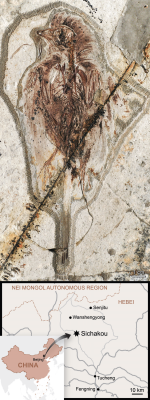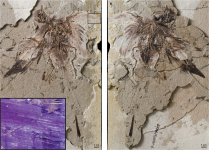Fred Ruhe
Well-known member

A paper I forgot to mention:
Luis M. Chiappe, Liu Di, Francisco J. Serrano, Zhang Yuguang & Qingjin Meng, 2020
Anatomy and Flight Performance of the Early Enantiornithine Bird Protopteryx fengningensis: Information from New Specimens of the Early Cretaceous Huajiying Formation of China.
The Anatomical Record 303(4): 716-731
doi: https://doi/10.1002/ar.24322
https://anatomypubs.onlinelibrary.wiley.com/doi/10.1002/ar.24322
Free pdf: https://anatomypubs.onlinelibrary.wiley.com/doi/pdf/10.1002/ar.24322
Abstract:
The Early Cretaceous (131 Million Years Ago) Protopteryx fengningensisis one of the oldest and most primitive enantiornithine birds; however, knowledge of its anatomy has largely been limited to the succinct description of two specimens (holotype and paratype). This study describes two new specimensof P. fengningensis preserving most of the skeleton and plumage, and it therefore adds significantly to understanding the morphology of this important spe-cies and the character evolution of enantiornithine birds. The well-preserved plumage of these specimens also affords a quantitative assessment of the flight performance of P. fengningensis. Our aerodynamic considerations indicate that this early enantiornithine was capable of intermittent flight (bounding or flap-gliding), thus marking the earliest occurrence of suchenergy-saving aerial strategy.
Enjoy,
Fred
Luis M. Chiappe, Liu Di, Francisco J. Serrano, Zhang Yuguang & Qingjin Meng, 2020
Anatomy and Flight Performance of the Early Enantiornithine Bird Protopteryx fengningensis: Information from New Specimens of the Early Cretaceous Huajiying Formation of China.
The Anatomical Record 303(4): 716-731
doi: https://doi/10.1002/ar.24322
https://anatomypubs.onlinelibrary.wiley.com/doi/10.1002/ar.24322
Free pdf: https://anatomypubs.onlinelibrary.wiley.com/doi/pdf/10.1002/ar.24322
Abstract:
The Early Cretaceous (131 Million Years Ago) Protopteryx fengningensisis one of the oldest and most primitive enantiornithine birds; however, knowledge of its anatomy has largely been limited to the succinct description of two specimens (holotype and paratype). This study describes two new specimensof P. fengningensis preserving most of the skeleton and plumage, and it therefore adds significantly to understanding the morphology of this important spe-cies and the character evolution of enantiornithine birds. The well-preserved plumage of these specimens also affords a quantitative assessment of the flight performance of P. fengningensis. Our aerodynamic considerations indicate that this early enantiornithine was capable of intermittent flight (bounding or flap-gliding), thus marking the earliest occurrence of suchenergy-saving aerial strategy.
Enjoy,
Fred





